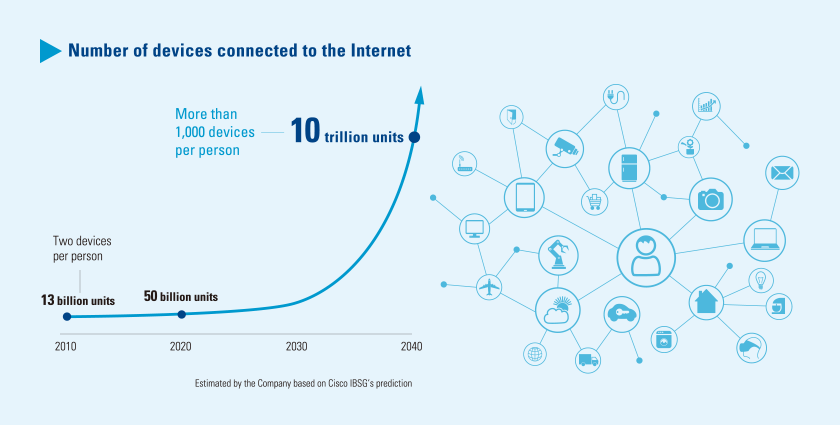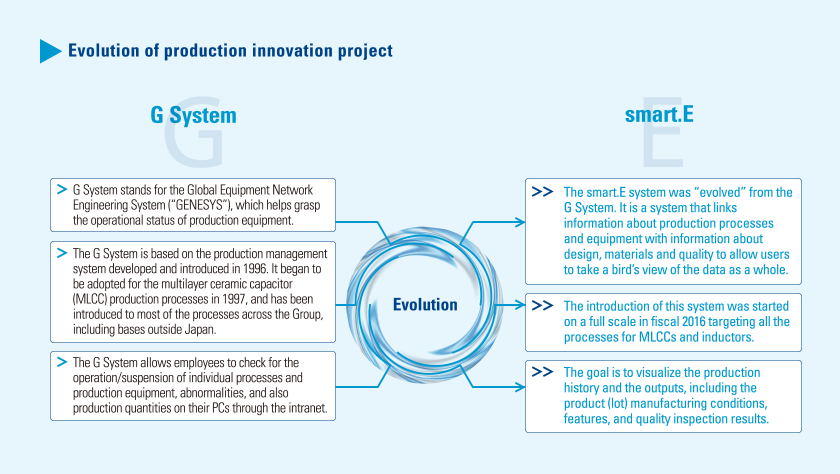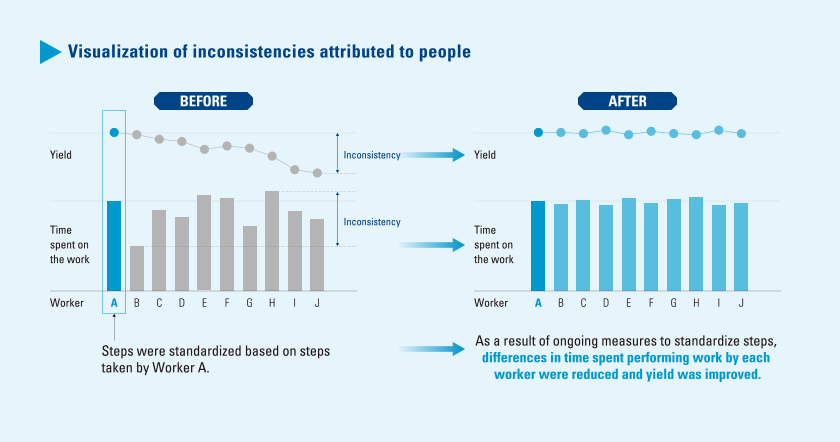Special Feature:
Production Innovation smart.E Project Aimed at the Arrival of the IoT Era

Drastically Expanding Demand for Electronic Components in the Era of IoT
IoT, which connects all things around us with the Internet, is evolving. As telecommunication functions are added to objects that have never been connected to the Internet before, the number and type of electronic components that are used will inevitably increase. It has been said that the number of Internet devices will increase from about 13 billion as of 2010 to 10 trillion in 2040, and accompanying this the demand for electronic components is expected to rise explosively.
These changes in the environment are a business chance for the Company as it supplies electronic components that are used in various devices, and at the same time they can be a risk as the Company could be left behind by the competition if it is not capable of building an efficient production system in line with this increase in volume. For this reason, we are implementing the new production innovation activity, smart.E project.

Efforts Before the smart.E Project
Up until now, the Company has introduced a production management system called the G System to manage the operation status of the production process.
The G System monitors individual production facilities to enable a real-time understanding of matters including the operation or suspension status, the presence of abnormalities, and production volume. Since operations were commenced at some plants in 1996, it has been introduced to nearly the entire multilayer ceramic capacitor production process including at overseas bases to enable the visualization of processes.
Evolution from the G System to smart.E
While the G System attempted to improve operational efficiency per facility unit, the smart.E project works to improve productivity as a whole by newly joining the entire production system. The smart.E project aims to significantly reduce the rate of defects and improve profitability by enhancing productivity.
In order to achieve this goal, we will improve productivity through the two approaches of the visualization of production equipment and the visualization of labor force, and also aim to maximize the results through the fusion of these approaches.
In terms of equipment, we plan to build a framework for the efficient operation of equipment through the three steps of visualization, early detection, and prevention for abnormalities that would cause a decline in the rate of quality products or the suspension of operations. In the fiscal year ended March 31, 2017, the first fiscal year of the project, we focused mainly on the visualization of abnormalities. Specifically, we implemented a cycle of gathering the information for each production system in one location and joining together the information for all processes, identifying inconsistency by analyzing the data that is collected for each process, and clarifying the problems in order to control variation.
At the same time, we have commenced the visualization of labor force. Through this effort, we consider what kind of cases lead to the occurrence of defects or deterioration in work efficiency, and what can be done to improve efficiency, focusing on inconsistency among people who operate facilities. Then we conduct an analysis of the causes of the above problems and begin to reflect results in work improvements and a reduction in the work load. While inconsistency in equipment is due to factors that are relatively predictable, such as the life, wear or deformations in the parts being used, variation in people cannot be completely eliminated due to factors such as the skills and experience of individuals, as well as uncertain factors such as physical condition and the surrounding atmosphere. In order to minimize areas that are affected by variation among people, we will introduce frameworks to reduce the actual load on people and work to improve productivity.

Future Efforts
—Development of Scientists to Analyze Data—
During the fiscal year ending March 31, 2018, the second year of the project, we have begun to conduct analysis that leads to improvements in production efficiency while analyzing data. Particularly, in efforts regarding equipment, we are building a framework for the early detection of abnormalities and provision of feedback to the production process by defining what is abnormal and normal in production processes and products. What is needed in situations like these are human resources who are capable of analyzing the large volume of big data collected to clarify issues and make meaningful proposals, and furthermore, who can conduct all this work quickly. As human resource development is a critical theme that will have a decisive effect on the achievements of the smart.E project, we promote the learning of statistical knowledge and improvements in analysis technology skills in order to develop data scientists. We will establish data analysis methodologies and accumulate best practices for full-scale deployment to production bases in Japan and overseas.

Achievements Generated by smart.E
The explosive increase in demand for electronic components with the arrival of the IoT era will be a business opportunity for the Company. On the other hand, achieving a balance between expanding production volumes and stable quality is becoming an important management issue as the level of quality demanded is becoming more and more advanced in high reliability markets such as automobiles, which the TAIYO YUDEN Group aims to fully enter. However, there will be no limit to the increase in costs if we blindly increase or enhance personnel and equipment in response to the rising demand for electronic components.
As an electronic components manufacturer that will support the rapidly evolving IoT society, we recognize the role that we should play as an extremely important one, and accordingly we will eliminate muda (wastefulness), mura (inconsistency), and muri (excessive burden) in production processes through the smart.E project along with capacity expansion to reduce losses, for the purpose of building a production system capable of supporting an unprecedented increase in production volumes.
This website contains forward-looking statements. These forward-looking statements are not guarantees of future performance, and they involve inherent risks and uncertainties.
A variety of factors including changes in the business environment could cause actual results to differ materially from those in the forward-looking statements.